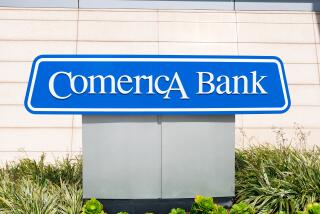S&L; Crisis in Ohio Fading but Changes Remain
- Share via
CINCINNATI — The panic, and the lines of nervous depositors, are long gone. At the main office of Charter Oak Savings Assn. in Cincinnati, where 1,000 worried savers camped out waiting for the doors to open at the height of the Ohio S&L; crisis in mid-March, calm reigns once again.
Customer traffic is now light at Charter Oak and at the other privately insured thrifts hit by runs in March; after the state government intervened to protect customers’ deposits and to require that the firms seek federal deposit insurance, consumer confidence in the institutions seems to be slowly returning. State officials proudly note that not one depositor has lost a penny so far from any of the savings and loans.
“I never did have any fears about Charter Oak,” says 41-year-old Lois Baumer of Cincinnati, who has much of her savings at the thrift and was depositing some more last Thursday.
“It hasn’t been a hardship on me,” adds Harold Gulley, 64, a retired machinist and a depositor at Cincinnati’s Tri-State Savings & Loan, which just reopened for full service last week. “I didn’t have a problem meeting my bills” during the period that Tri-State was open only for limited withdrawals, he says. “I knew this thing would work itself out.”
Still, almost three months after one of the nation’s worst financial system panic since the Great Depression, Ohio’s state-chartered, privately insured thrifts are just now picking up the pieces.
The biggest problem in the aftermath of the crisis was finally solved last week with the sale of Home State Savings Bank, the Cincinnati-based thrift whose collapse as a result of heavy investments with a failed Florida government securities dealer sparked the panic.
Home State, which has remained closed and under state conservatorship since its failure in March, was acquired by Hunter Savings Assn., a Cincinnati-based, federally insured thrift controlled by financier Carl H. Lindner.
Home State’s huge losses from its dealings with ESM Government Securities of Fort Lauderdale effectively liquidated the $130-million private insurance fund that backed up Ohio’s thrifts, resulting in a run in mid-March on other privately insured S&Ls; by depositors worried that their savings were no longer protected. (The state’s federally insured savings and loans were not affected by the crisis.)
As the panic escalated, especially in the Cincinnati area, Ohio Gov. Richard F. Celeste was forced on March 15 to order the nation’s biggest banking holiday since the 1930s. He ordered all 70 of the non-federally insured thrifts to remain closed for three days. Later, he hammered out a plan that allowed individual S&Ls; to reopen for full service only after obtaining or qualifying for federal deposit insurance.
In the interim, the Ohio Legislature also established a new fund making state loans available to the weakest S&Ls; to help them meet the financial requirements for federal deposit insurance. The Legislature also provided a subsidy that will be used by Hunter to help recapitalize Home State.
But in the wake of the crisis, as government examiners combed through the books of each thrift in order to see which could qualify for federal insurance, it became increasingly clear that many lacked adequate capital reserves to continue as independent institutions under the federal system.
So, with prodding from federal and state regulators, the March crisis has since sparked a swift shakeout among the state’s savings and loans. Almost every week brings news of mergers and acquisitions among Ohio’s weakened thrifts as they attempt to improve their financial health in order to qualify for deposit insurance under the relatively strict standards of the Federal Savings and Loan Insurance Corp.
To accelerate the process, the state Legislature even passed an emergency bill allowing out-of-state banks to enter the Ohio market for the first time in order to take over troubled S&Ls; and convert them into commercial banks.
Consolidation of Industry
“Within five years, the number of savings and loans in Ohio is going to be half what it was before the crisis,” predicts Peter Bergman, president of Tri-State, which, along with five other local thrifts, is being acquired by Chase Manhattan Corp. for conversion into one Ohio commercial bank. “The crisis is accelerating the consolidation of the industry.”
State officials say that, besides Home State, 20 of the privately insured thrifts have been merged into stronger institutions with federal insurance since March, while about 35 others have received insurance on their own and have reopened for full service.
Seven others are open for limited withdrawals of up to $1,000 per customer a month but have been barred by state regulators from reopening for full service.
At least another three, including Charter Oak, have been given approval by the state to reopen pending the final acceptance of their federal insurance applications, but they have voluntarily kept their limited withdrawal status until they obtain insurance, according to Thomas Batties, chief counsel for the Ohio Division of Savings and Loan Associations.
All of the thrifts must obtain federal insurance by midsummer or they could become subject to takeover by the state, which would then attempt to obtain FSLIC insurance for them, Batties says.
Until those last few problem thrifts are taken off the sick list, state officials are cautiously refusing to claim that the thrift emergency is over.
“I wouldn’t term the crisis over until the depositors of Home State, and of the institutions that are only partially open, have full access to their money,” says Rick Spencer, spokesman for the Ohio Department of Commerce.
(Hunter Savings says it would like to reopen Home State’s offices, which will be merged into its own operations, two weeks after it receives court approval for the takeover. A state court in Cincinnati approved the sale Monday.)
In the meantime, a special prosecutor has been appointed to conduct a criminal investigation into allegations of fraud at Home State, and a joint committee of the state Legislature is studying why Ohio’s savings and loan regulators failed to take action to stop Home State from making such large and risky investments with ESM before it was too late.
Besides the trauma that it has caused among the state’s old-line, family-owned thrifts, the crisis here has also opened a back door to interstate banking, since the state Legislature has enabled big out-of-state commercial banks to rush into Ohio to rescue the savings and loans.
Since the crisis, several big financial institutions from around the country have attempted to enter the market, with mixed results. Chase Manhattan has been successful in its bid to buy six Ohio thrifts, but Chemical Bank of New York lost out to Hunter in its efforts to acquire Home State for conversion into a commercial bank.
Meanwhile, out-of-state savings and loans are also moving in. Magnet Bank of West Virginia, a federal savings bank, is in the process of acquiring Anchor Savings of Hillsboro, Ohio, while Los Angeles-based Home Savings of America has bought four Ohio thrifts and is negotiating to buy a fifth.
This ad hoc invasion worries Linda Paige, Ohio’s banking commissioner, who, before the crisis, had been pushing for legislation designed to move Ohio gradually into interstate banking.
“I would have preferred a more systematic approach to interstate banking for Ohio,” Paige says. But now that it has happened, she believes that the crisis will pave the way for passage of a new law that will allow nationwide banking competition in Ohio within four years.
Other States Affected
The repercussions outside of the state from the Ohio crisis are also still being felt. Along with a similar crisis last month in Maryland, the Ohio breakdown has prompted dozens of privately insured S&Ls; in other states to scramble nervously for federal backing, placing an even greater burden on the already overtaxed $6-billion FSLIC insurance fund for the troubled savings and loan industry.
In fact, the sudden panics in Ohio and Maryland, industry officials here believe, spell the end of private insurance funds across the nation. In addition to Ohio and Maryland, Massachusetts, North Carolina, Georgia and Pennsylvania have some privately insured thrifts.
“The lesson from all of this is that we’ve got to hope the United States stands behind the nation’s financial institutions,” says Laird Lazelle, executive vice president of Charter Oak, which lost $50 million, or 15%, of its deposits during a two-week period in March. “You need something big standing behind the system to give people confidence, and the private insurance funds aren’t big enough.”
More to Read
Inside the business of entertainment
The Wide Shot brings you news, analysis and insights on everything from streaming wars to production — and what it all means for the future.
You may occasionally receive promotional content from the Los Angeles Times.










